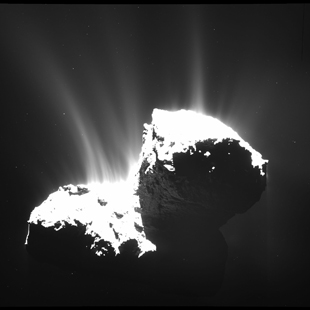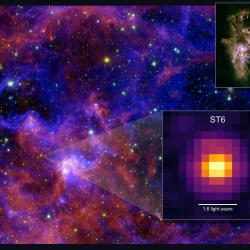University of Maryland to Have Key Role in Possible NASA Comet Mission
Two UMD astronomers will make key contributions to development of mission selected under NASA’s New Frontiers program.
Two University of Maryland astronomers will make key contributions to one of two final concepts that NASA selected for further development under its New Frontiers program.
 If selected for deployment, the Comet Astrobiology Exploration Sample Return (CAESAR) mission will seek to retrieve primitive material from comet 67P/Churyumov-Gerasimenko. Comet 67P made headlines as the target of the European Space Agency’s Rosetta spacecraft mission, which orbited the comet from 2014 through 2016.
If selected for deployment, the Comet Astrobiology Exploration Sample Return (CAESAR) mission will seek to retrieve primitive material from comet 67P/Churyumov-Gerasimenko. Comet 67P made headlines as the target of the European Space Agency’s Rosetta spacecraft mission, which orbited the comet from 2014 through 2016.
Dennis Bodewits and Michael Kelley, both associate research scientists in the UMD Department of Astronomy, will lead the Comet Environment Working Group for the CAESAR team. In this role, they will assess the risks that the comet’s harsh surface environment would pose to the spacecraft and will help define the technical requirements for the sample acquisition system.
“The University of Maryland has a strong legacy in comet science, having led the Deep Impact mission and played key roles in Stardust-NExT and Rosetta,” Bodewits said. “We picked 67P because going to a comet we’ve seen before enormously reduces the risk of collecting a sample. In addition, the comet will also have done two more orbits around the sun, so the CAESAR mission will help us to learn a lot more about how comets evolve.”
NASA announced the finalists Dec. 20, 2017, following a competitive peer review of 12 proposals submitted in April. CAESAR would be managed by NASA’s Goddard Space Flight Center in Greenbelt, Maryland.
CAESAR and the second finalist—a mission named Dragonfly that would explore Saturn’s moon Titan—will receive “Phase A” support through the end of 2018 to further develop their concepts. NASA plans to select one of these investigations in spring 2019 to continue on to subsequent mission development phases.
If selected, CAESAR will “produce groundbreaking science for decades to come,” said Cornell University’s Steven Squyres, the mission’s principal investigator. “The end date of the flight will really be the beginning. The science will extend for decades after the sample comes back.
CAESAR would launch in 2024 and would return approximately 100 grams of material from the surface of comet 67P in 2038. This comet material could contain a wealth of new information and clues to the origin and history of the solar system.
“It may not sound like much, but that 100 grams would revolutionize comet science,” Kelley said. “We’re used to dealing with tiny grains captured by Stardust or by aircraft flying in the stratosphere. But those grains are missing the delicate pre-biotic organics that are best collected at the surface of a comet. Having large amounts of gently collected material and access to labs here on Earth will change the game completely. You can only miniaturize certain instruments to fly on a space mission like Rosetta. And who knows what laboratory instruments might be available in 2038.”
The selected mission will be the fourth project from the NASA New Frontiers program, a series of planetary science investigations that fall under a development cost cap of approximately $850 million. Its predecessors are the New Horizons mission to Pluto, the Juno mission to Jupiter and OSIRIS-REx, which will rendezvous with asteroid Bennu this year and, if successful, return a sample of the asteroid in 2023.
###
This release is modified from text provided by Cornell University.
Media Relations Contact: Matthew Wright, 301-405-9267, mewright@umd.edu
University of Maryland
College of Computer, Mathematical, and Natural Sciences
2300 Symons Hall
College Park, MD 20742
www.cmns.umd.edu
@UMDscience
About the College of Computer, Mathematical, and Natural Sciences
The College of Computer, Mathematical, and Natural Sciences at the University of Maryland educates more than 9,000 future scientific leaders in its undergraduate and graduate programs each year. The college's 10 departments and more than a dozen interdisciplinary research centers foster scientific discovery with annual sponsored research funding exceeding $175 million.







